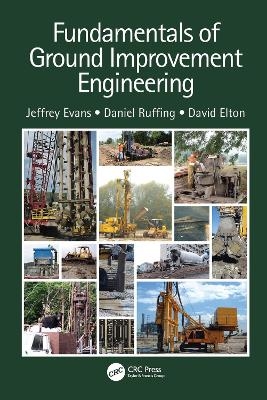
Fundamentals of Ground Improvement Engineering
Seiten
2023
CRC Press (Verlag)
978-0-415-69512-1 (ISBN)
CRC Press (Verlag)
978-0-415-69512-1 (ISBN)
- Titel ist leider vergriffen;
keine Neuauflage - Artikel merken
This textbook addresses the current ground improvement techniques and also suits professionals. It introduces key methods, with the underpinning theory, design principles, and construction approaches. It contains numerous problems and worked examples, and a companion website providing instructor resources and videos of the techniques.
Ground improvement has been one of the most dynamic and rapidly evolving areas of geotechnical engineering over the past forty years. Moreover, increasing development of sites with marginal soils has made ground improvement an increasingly important core component of geotechnical engineering curricula. This textbook addresses the latest and most effective techniques for ground improvement, at a level designed for undergraduate and graduate-level university students and practitioners seeking fundamental background in these techniques.
Thus, Fundamentals of Ground Improvement Engineering is for students and professionals. The book is written to, first, broadly introduce key ground improvement methods and, second, to provide readers with a thorough understanding of the theory, design principles, and construction approaches that underpin each method. Major topic areas covered include compaction, grouting, vibratory methods, soil mixing, stabilization and solidification, cut-off walls, dewatering, consolidation, geosynthetics, and earth retention.
The book contains numerous problems and worked examples, and is well illustrated with photographs, schematics, charts and graphs. The rich companion website provides instructor resources and videos of the techniques, which are useful for students and for professionals to show clients.
Ground improvement has been one of the most dynamic and rapidly evolving areas of geotechnical engineering over the past forty years. Moreover, increasing development of sites with marginal soils has made ground improvement an increasingly important core component of geotechnical engineering curricula. This textbook addresses the latest and most effective techniques for ground improvement, at a level designed for undergraduate and graduate-level university students and practitioners seeking fundamental background in these techniques.
Thus, Fundamentals of Ground Improvement Engineering is for students and professionals. The book is written to, first, broadly introduce key ground improvement methods and, second, to provide readers with a thorough understanding of the theory, design principles, and construction approaches that underpin each method. Major topic areas covered include compaction, grouting, vibratory methods, soil mixing, stabilization and solidification, cut-off walls, dewatering, consolidation, geosynthetics, and earth retention.
The book contains numerous problems and worked examples, and is well illustrated with photographs, schematics, charts and graphs. The rich companion website provides instructor resources and videos of the techniques, which are useful for students and for professionals to show clients.
1. Introduction to Ground Improvement Engineering 2. Geotechnical Engineering Principles relating to Ground Improvement 3. Compaction Methods 4. Grouting 5. Vibro Ground Improvement Methods 6. Soil Mixing and Injection 7. Stabilization and Solidification 8. Cutoff Walls 9. Dewatering with wells and drains 10. Consolidation 11. Earth Retention 12. Structural Support
| Erscheint lt. Verlag | 31.12.2023 |
|---|---|
| Zusatzinfo | 90 Tables, black and white; 200 Line drawings, black and white; 90 Halftones, black and white |
| Verlagsort | London |
| Sprache | englisch |
| Maße | 178 x 254 mm |
| Themenwelt | Naturwissenschaften ► Geowissenschaften ► Geologie |
| Technik ► Bauwesen | |
| Technik ► Umwelttechnik / Biotechnologie | |
| ISBN-10 | 0-415-69512-0 / 0415695120 |
| ISBN-13 | 978-0-415-69512-1 / 9780415695121 |
| Zustand | Neuware |
| Informationen gemäß Produktsicherheitsverordnung (GPSR) | |
| Haben Sie eine Frage zum Produkt? |
Mehr entdecken
aus dem Bereich
aus dem Bereich
Baugruben und Gründungen
Buch | Hardcover (2024)
Springer Fachmedien Wiesbaden GmbH (Verlag)
59,99 €


